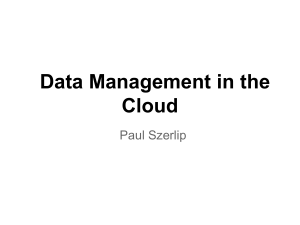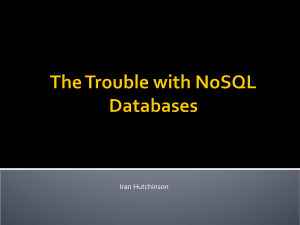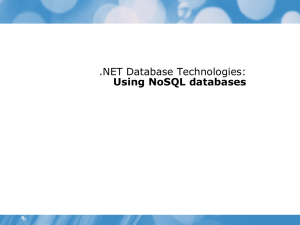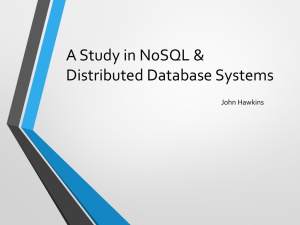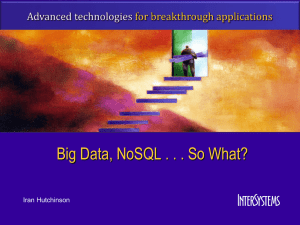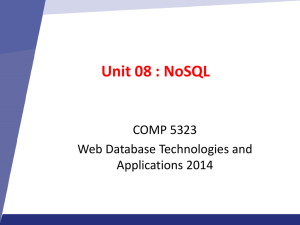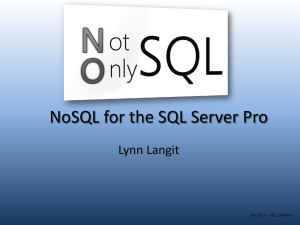NoSQL Databases: MongoDB vs Cassandra
advertisement
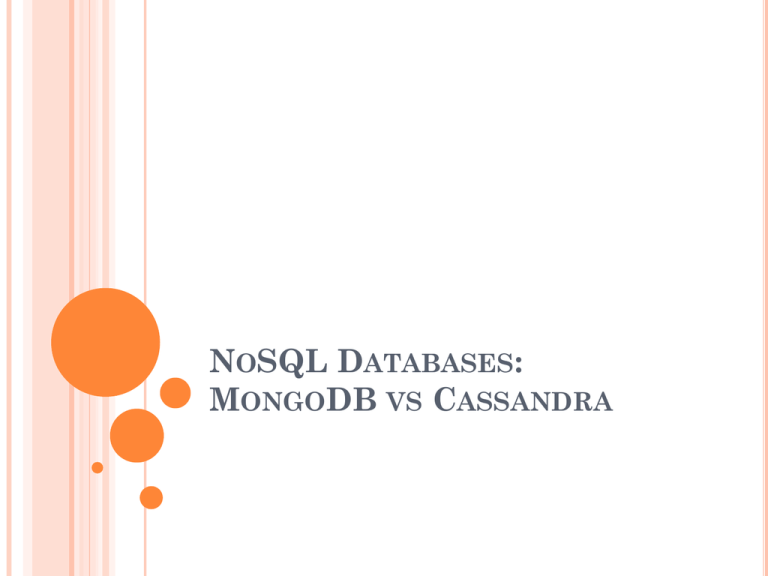
NOSQL DATABASES: MONGODB VS CASSANDRA INTRODUCTION What is a Database? “… a repository with organized and structured data, … “ (Abramova & Bernardino, 2013-07) Data can be accessed using DBMS (DataBase Management System) What is DBMS? “ DBMS can be defined as a collection of mechanisms that enables storage, edit and extraction of data” (Abramova & Bernardino, 2013-07) SQL SQL: Structured Query Language Became standard for: Data interaction Data manipulation Data Stored as set of tables Accessing data from different tables at the same time is possible. NOSQL Carlo Strozzi presented NoSQL in 1980, back then, it refers to an open source database that didn’t use SQL interface. Carlo Strozzi preferred to call it “noseequel” or “NoRel” Principle Difference Popular after San Francisco conference held 2009 Why do we need NoSQL? In SQL ,efficiency in information extraction is affected by the growth of data stored & used CAP THEOREM Based from CAP theorem, the following guarantees can be defined: Consistency Availability Partition tolerance CAP theorem derives Relational and NoSQL principles ACID “ACID is a principle based on CAP theorem and used as set of rules for relational database transactions.“ (Abramova & Bernardino, 2013-07) ACID guarantees: Atomic Consistent Isolated Durable What if the amount of data is large? ACID may be hard to accomplish! BASE PRINCIPLE & NOSQL BASE principle: Basically Available Soft state Eventually consistent BASE still follows CAP theorem. Two of the three guarantees should be selected if the system is distributed. TYPES OF NOSQL DATABASES More than 150 different NoSQL databases Based on same principles Has some different characteristics. Categories: Key-value Store Document Store Column-family Graph database KEY-VALUE STORE Data is stored as a group of key and value All keys are unique Data Access is done by relating those keys to values Hash contains all keys in order to provide information when needed DOCUMENT STORE Databases are defined as set of Key-value stores that gets transformed into documents. Each document is identified by unique key Data access can be done using: key specific value COLUMN FAMILY Similar to relational database model Structure: Column Super-Column Column family Structure of database is defined by supercolumns and column families. Data access is accomplished by specifying column family, key and column in order to get value, using following structure: <columnFamily>.<key>.<column> = <value> GRAPH DATABASE Those databases are used when data can be represented as graph, for example, social networks. MONGODB “MongoDB is an open source NoSQL database developed in C++” (Abramova & Bernardino, 2013-07). MongoDB is a document store database Documents are gathered into groups according to their structure CAP theorem Consistency Partition tolerance MONGODB (CONT.) Description Data is sent to disc every 60 seconds. Everything is flushed to disc once new files are created Each document is identified by “id” field An index for the “id” field is created Characteristics Durability Concurrency MONGODB CHARACTERISTICS Durability Durability of data is accomplished by the creation of replicas. Master-Slave technique Master: read & write Slave: read Slave with recent data becomes Master if the Master goes down Replicas are asynchronous Concurrency Locks CASSANDRA “Cassandra is a NoSQL database developed by Apache Software Foundation; written in Java” (Abramova & Bernardino, 2013-07) Similar to the usual relational model Difference is that stored data can be: semi structured unstructured. CAP theorem Partition tolerance High Availability Designed to save large amount of data and deal with huge volumes in an efficient way. CASSANDRA (CONT.) Peer-to-peer architecture (NO MASTER) High availability High scalability Replicates data over multiple nodes in a cluster. Replication Factor: Total number of replicas. RF(1): 1 copy of each row on 1 node RF(2): 2 copies of same records on 2 nodes Fail nodes are replaced with no downtime, and they are detected using “gossip” protocols CASSANDRA (CONT.) Replication Strategy: Simple: single data center Network Topology: multiple data centers Cassandra Characteristics: Durability: Two replication types: Synchronous Asynchronous All writes & redundancies are known using a commit log. Indexing: “Each node maintains the indexes of the table it manages” Data is manipulated using CQL YCSB “The YCSB – Yahoo! Cloud Serving Benchmark is one of the most used benchmarks to test NoSQL databases” (Abramova & Bernardino, 2013-07). YCSB has a client that consists of two parts: Workload generator Set of workloads. Workloads are combinations of: read Write update operations are done on randomly chosen records. WORKLOAD A: 50%READS & 50% UPDATES Abramova, V., & Bernardino, J. (2013-07). NoSQL Databases: MongoDB vs Cassandra. 19 WORKLOAD B: 95% READS & 5%UPDATES Abramova, V., & Bernardino, J. (2013-07). NoSQL Databases: MongoDB vs Cassandra. 20 WORKLOAD C: 100% READS Abramova, V., & Bernardino, J. (2013-07). NoSQL Databases: MongoDB vs Cassandra. 20 WORKLOAD F: READ-MODIFY-WRITE Abramova, V., & Bernardino, J. (2013-07). NoSQL Databases: MongoDB vs Cassandra. 20 WORKLOAD G: 5% READS 95% UPDATES Abramova, V., & Bernardino, J. (2013-07). NoSQL Databases: MongoDB vs Cassandra. 20 WORKLOAD H: 100% UPDATES Abramova, V., & Bernardino, J. (2013-07). NoSQL Databases: MongoDB vs Cassandra. 21
